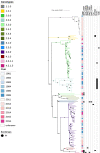Whole genome sequence analysis of Salmonella Typhi provides evidence of phylogenetic linkage between cases of typhoid fever in Santiago, Chile in the 1980s and 2010-2016
- PMID: 35767580
- PMCID: PMC9275700
- DOI: 10.1371/journal.pntd.0010178
Whole genome sequence analysis of Salmonella Typhi provides evidence of phylogenetic linkage between cases of typhoid fever in Santiago, Chile in the 1980s and 2010-2016
Abstract
Typhoid fever epidemiology was investigated rigorously in Santiago, Chile during the 1980s, when Salmonella enterica serovar Typhi (S. Typhi) caused seasonal, hyperendemic disease. Targeted interventions reduced the annual typhoid incidence rates from 128-220 cases/105 population occurring between 1977-1984 to <8 cases/105 from 1992 onwards. As such, Santiago represents a contemporary example of the epidemiologic transition of an industrialized city from amplified hyperendemic typhoid fever to a period when typhoid is no longer endemic. We used whole genome sequencing (WGS) and phylogenetic analysis to compare the genotypes of S. Typhi cultured from acute cases of typhoid fever occurring in Santiago during the hyperendemic period of the 1980s (n = 74) versus the nonendemic 2010s (n = 80) when typhoid fever was rare. The genotype distribution between "historical" (1980s) isolates and "modern" (2011-2016) isolates was similar, with genotypes 3.5 and 2 comprising the majority of isolations, and 73/80 (91.3%) of modern isolates matching a genotype detected in the 1980s. Additionally, phylogenomically 'ancient' genotypes 1.1 and 1.2.1, uncommon in the global collections, were also detected in both eras, with a notable rise amongst the modern isolates. Thus, genotypes of S. Typhi causing acute illness in the modern nonendemic era match the genotypes circulating during the hyperendemic 1980s. The persistence of historical genotypes may be explained by chronic typhoid carriers originally infected during or before the 1980s.
Conflict of interest statement
The authors have declared that no competing interests exist.
Figures




Similar articles
-
Persistence of Rare Salmonella Typhi Genotypes Susceptible to First-Line Antibiotics in the Remote Islands of Samoa.mBio. 2022 Oct 26;13(5):e0192022. doi: 10.1128/mbio.01920-22. Epub 2022 Sep 12. mBio. 2022. PMID: 36094088 Free PMC article.
-
Detecting Residual Chronic Salmonella Typhi Carriers on the Road to Typhoid Elimination in Santiago, Chile, 2017-2019.J Infect Dis. 2024 Aug 16;230(2):e254-e267. doi: 10.1093/infdis/jiad585. J Infect Dis. 2024. PMID: 38123455 Free PMC article.
-
Salmonella enterica Serovar Typhi in Bangladesh: Exploration of Genomic Diversity and Antimicrobial Resistance.mBio. 2018 Nov 13;9(6):e02112-18. doi: 10.1128/mBio.02112-18. mBio. 2018. PMID: 30425150 Free PMC article.
-
Five Years of GenoTyphi: Updates to the Global Salmonella Typhi Genotyping Framework.J Infect Dis. 2021 Dec 20;224(12 Suppl 2):S775-S780. doi: 10.1093/infdis/jiab414. J Infect Dis. 2021. PMID: 34453548 Free PMC article. Review.
-
Salmonella enterica serovar Typhi and the pathogenesis of typhoid fever.Annu Rev Microbiol. 2014;68:317-36. doi: 10.1146/annurev-micro-091313-103739. Annu Rev Microbiol. 2014. PMID: 25208300 Review.
Cited by
-
Typhoid fever.Nat Rev Dis Primers. 2023 Dec 14;9(1):71. doi: 10.1038/s41572-023-00480-z. Nat Rev Dis Primers. 2023. PMID: 38097589 Review.
-
Persistence of Rare Salmonella Typhi Genotypes Susceptible to First-Line Antibiotics in the Remote Islands of Samoa.mBio. 2022 Oct 26;13(5):e0192022. doi: 10.1128/mbio.01920-22. Epub 2022 Sep 12. mBio. 2022. PMID: 36094088 Free PMC article.
-
Detecting Residual Chronic Salmonella Typhi Carriers on the Road to Typhoid Elimination in Santiago, Chile, 2017-2019.J Infect Dis. 2024 Aug 16;230(2):e254-e267. doi: 10.1093/infdis/jiad585. J Infect Dis. 2024. PMID: 38123455 Free PMC article.
-
Global diversity and antimicrobial resistance of typhoid fever pathogens: Insights from a meta-analysis of 13,000 Salmonella Typhi genomes.Elife. 2023 Sep 12;12:e85867. doi: 10.7554/eLife.85867. Elife. 2023. PMID: 37697804 Free PMC article.
-
Assessing Salmonella Typhi Pathogenicity and Prevention: The Crucial Role of Vaccination in Combating Typhoid Fever.Int J Mol Sci. 2025 Apr 23;26(9):3981. doi: 10.3390/ijms26093981. Int J Mol Sci. 2025. PMID: 40362220 Free PMC article. Review.
References
-
- Levine MM BR, Ferreccio C, Clements ML, Lanata C, Sear S, Morris JG, et al.. Interventions to control endemic typhoid fever: field studies in Santiago, Chile. Control and Eradication of Infectious Diseases, An International Symposium. 1985;Series 1:37–53.
Publication types
MeSH terms
Grants and funding
LinkOut - more resources
Full Text Sources
Research Materials

